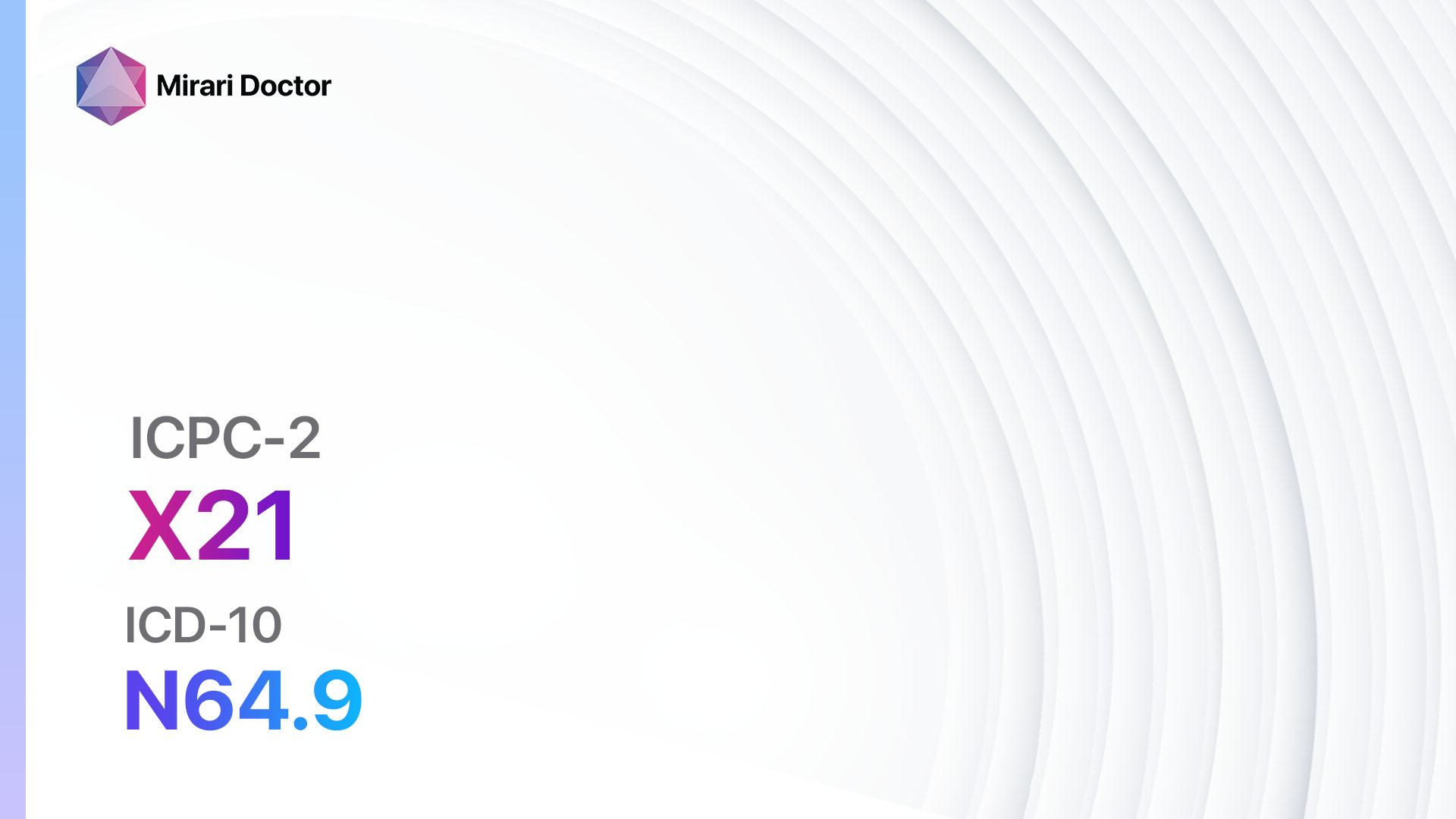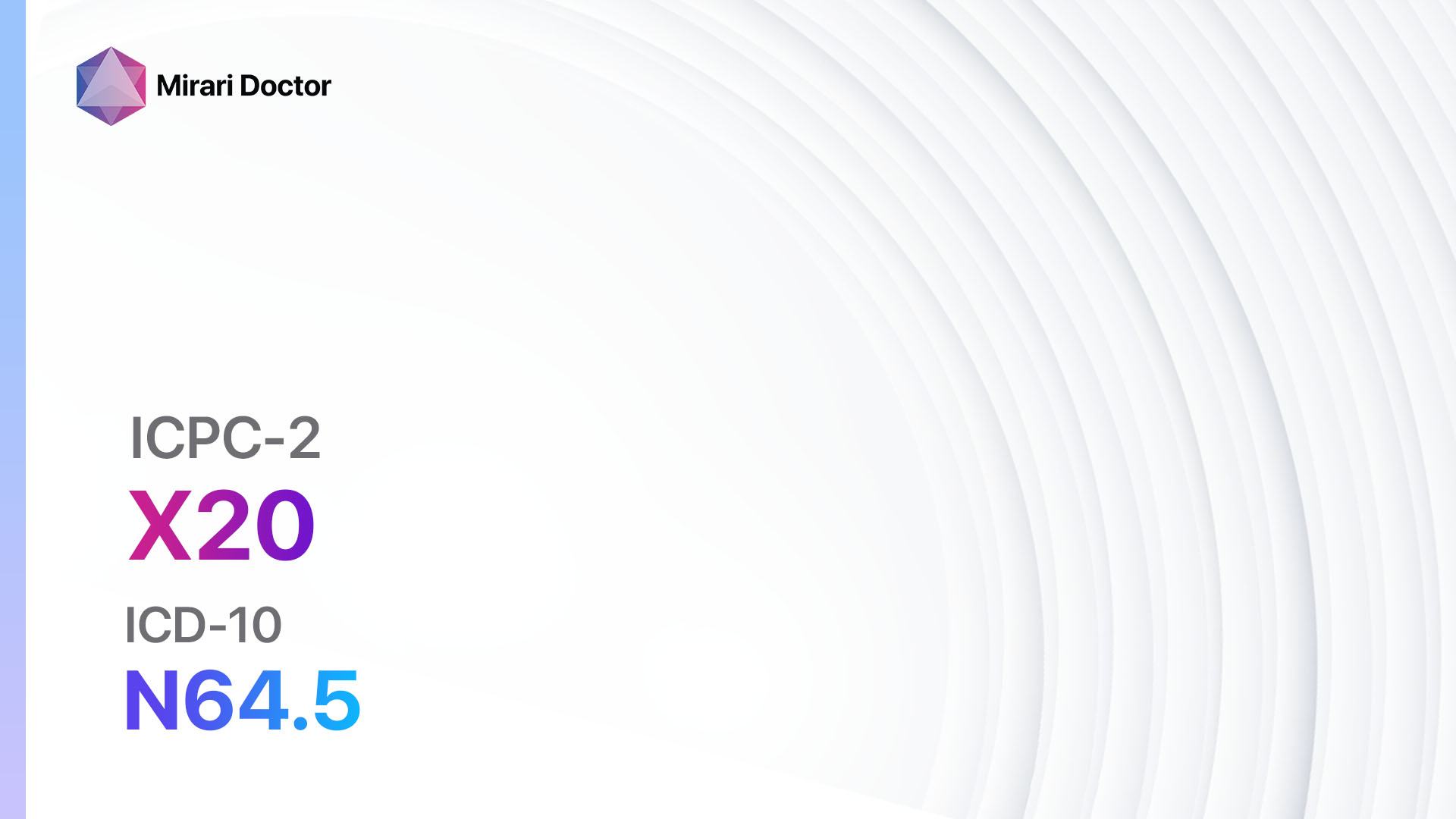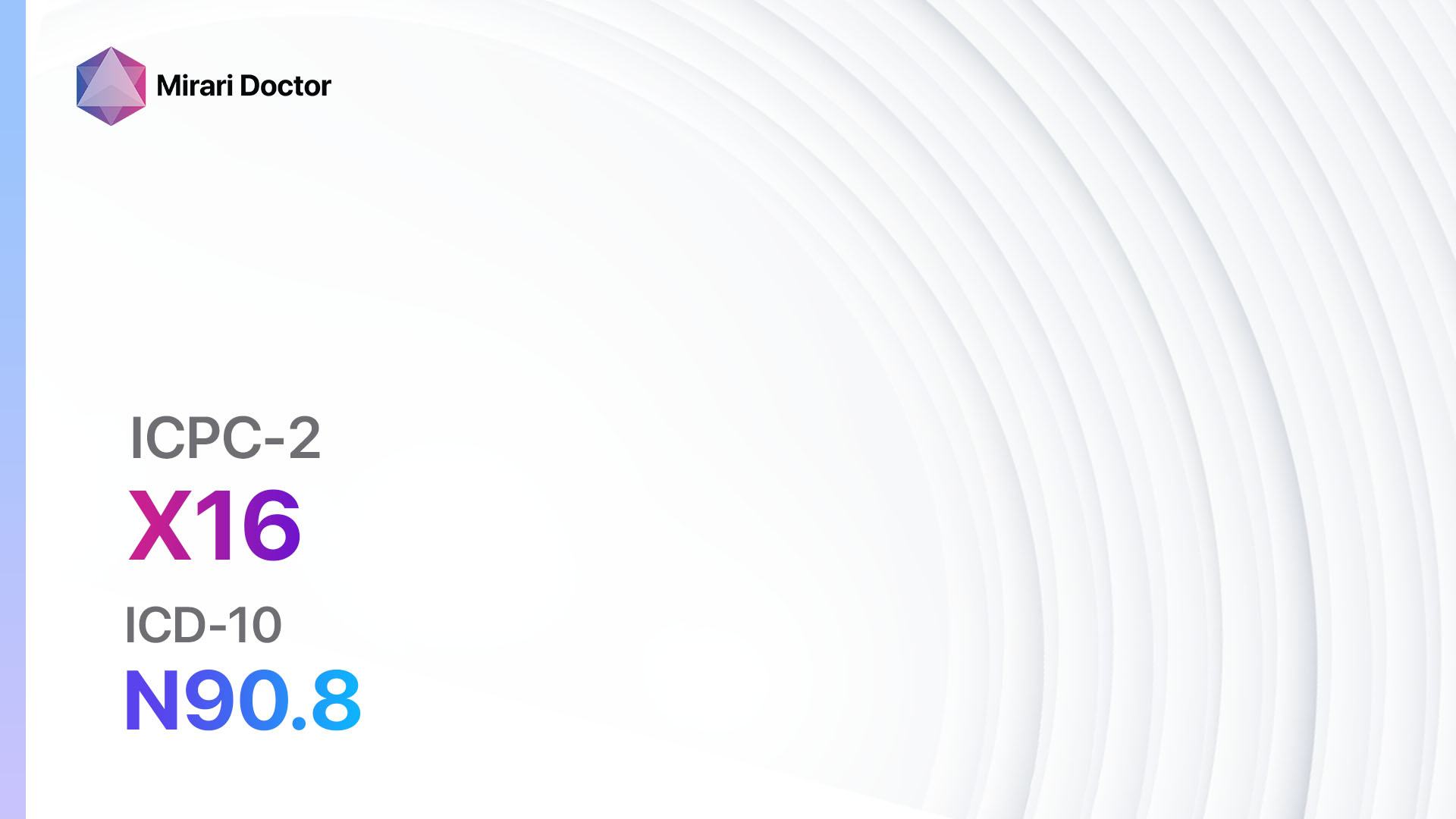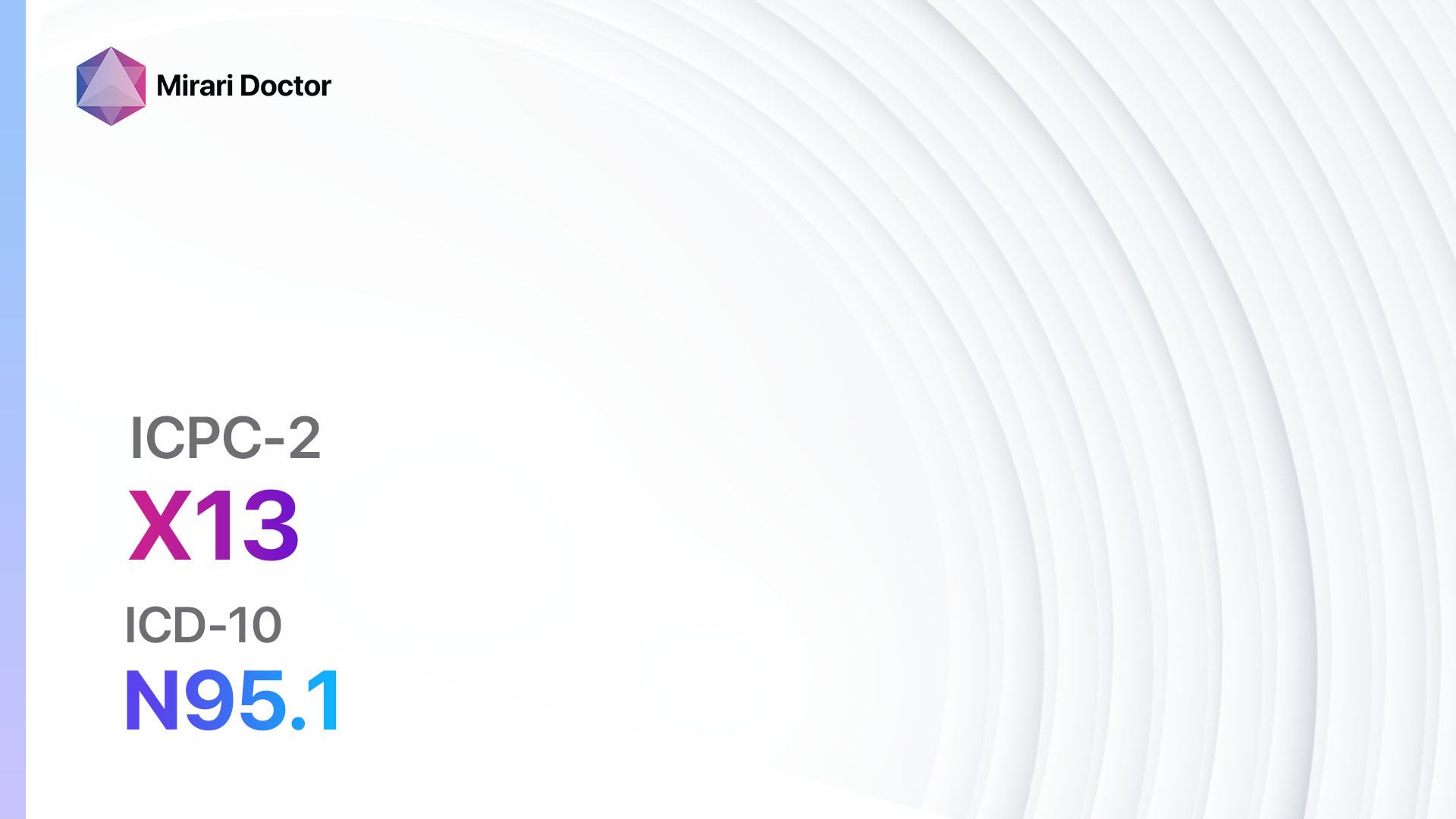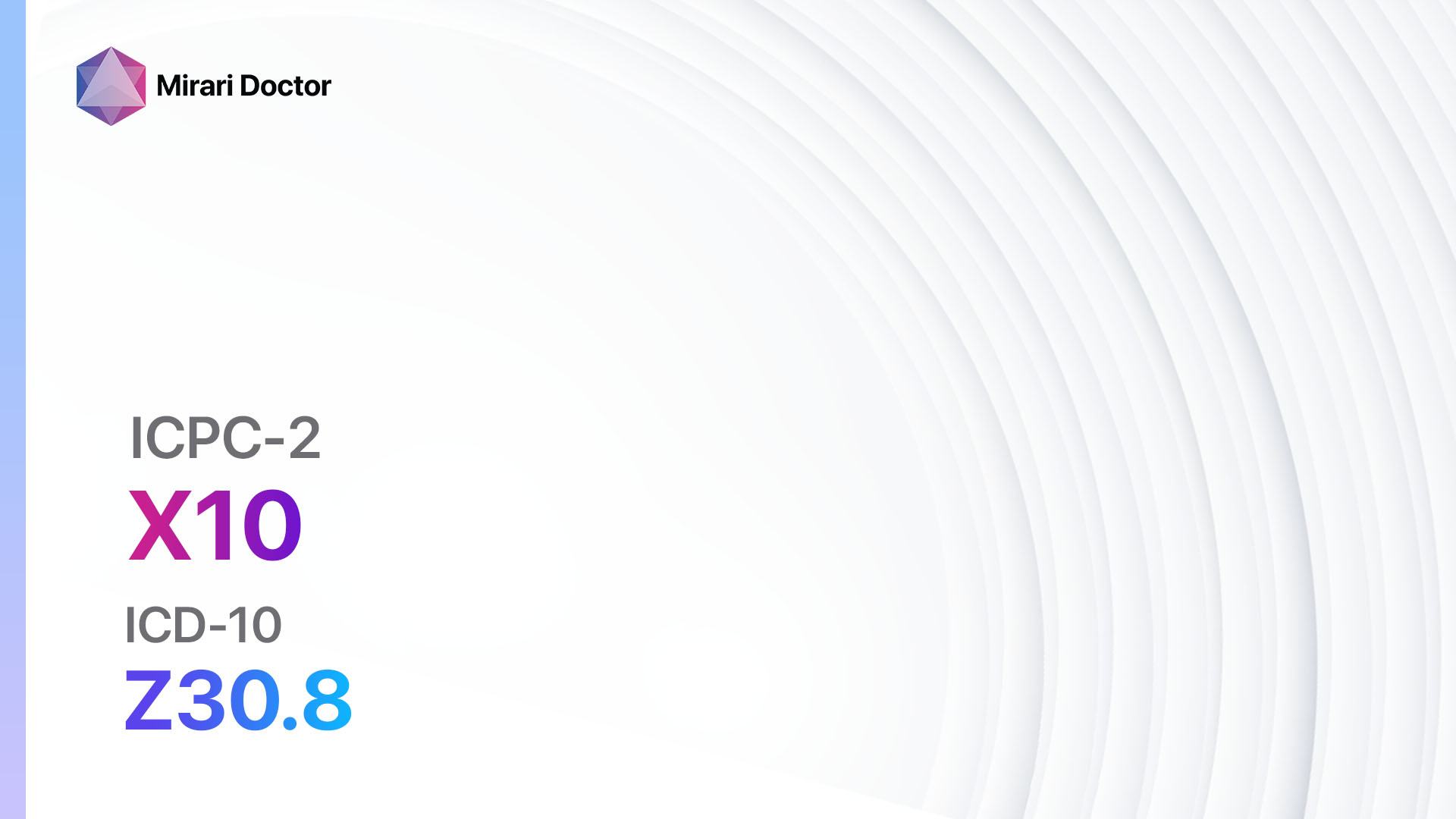
Introduction
Breast lumps or masses in females can be a cause of concern and may indicate various underlying conditions, including benign or malignant tumors[1]. It is essential to evaluate and diagnose breast lumps promptly to determine the appropriate course of treatment[2]. This guide aims to provide a comprehensive overview of the diagnostic steps, possible interventions, and lifestyle modifications for breast lumps in females.
Codes
Symptoms
- Presence of a palpable lump or mass in the breast
- Changes in breast size or shape
- Skin changes over the breast, such as dimpling or puckering
- Nipple changes, including inversion, discharge, or scaling
- Breast pain or tenderness[3]
Causes
- Fibrocystic changes: Common benign changes in breast tissue that can cause lumps or masses.
- Cysts: Fluid-filled sacs that can develop in the breast.
- Fibroadenomas: Benign tumors composed of glandular and fibrous tissue.
- Infections: Inflammatory conditions like mastitis or abscesses can cause breast lumps.
- Breast cancer: Malignant tumors that can present as breast lumps[4].
Diagnostic Steps
Medical History
- Gather information about the patient’s age, menstrual history, and any previous breast conditions.
- Assess family history of breast cancer or other relevant genetic factors.
- Inquire about symptoms, including the duration, changes in size or shape, and associated pain or discomfort.
- Evaluate any risk factors, such as hormonal therapy, obesity, or exposure to radiation[5].
Physical Examination
- Perform a thorough breast examination, including inspection, palpation, and assessment of lymph nodes.
- Note the characteristics of the lump, such as size, shape, mobility, and tenderness.
- Examine the skin and nipple for any changes or abnormalities.
- Assess the axillary and supraclavicular lymph nodes for enlargement or tenderness[6].
Laboratory Tests
- Breast ultrasound: Utilize ultrasound imaging to evaluate the characteristics of the lump, such as size, shape, and composition.
- Mammogram: X-ray imaging of the breast to detect any abnormalities, especially in women over 40 years of age.
- Breast MRI: Magnetic resonance imaging to provide detailed images of the breast tissue, useful for further evaluation of suspicious findings.
- Fine-needle aspiration (FNA): Extract a sample of cells from the lump using a thin needle for cytological examination.
- Core needle biopsy: Obtain a larger tissue sample using a wider needle for histological analysis[7].
Diagnostic Imaging
- Breast ultrasound: Utilize ultrasound imaging to evaluate the characteristics of the lump, such as size, shape, and composition.
- Mammogram: X-ray imaging of the breast to detect any abnormalities, especially in women over 40 years of age.
- Breast MRI: Magnetic resonance imaging to provide detailed images of the breast tissue, useful for further evaluation of suspicious findings.
- Tomosynthesis: 3D mammography that provides clearer images of breast tissue, especially in dense breasts[8].
Other Tests
- Genetic testing: Assess for specific gene mutations, such as BRCA1 and BRCA2, in patients with a strong family history of breast cancer.
- Ductography: Inject contrast dye into the milk ducts to evaluate any abnormalities or nipple discharge.
- PET-CT scan: Whole-body imaging to determine the extent of cancer spread in cases of suspected malignancy[9].
Follow-up and Patient Education
- Provide the patient with a clear explanation of the diagnostic findings and their implications.
- Discuss the need for further tests or consultations with specialists, such as breast surgeons or oncologists.
- Educate the patient about breast self-examination and the importance of regular mammograms for early detection.
- Offer emotional support and counseling to address any concerns or anxieties related to the diagnosis[10].
Possible Interventions
Traditional Interventions
Medications:
Top 5 drugs for Breast lump/mass female:
- Tamoxifen:
- Cost: $50-$200/month.
- Contraindications: History of blood clots, endometrial cancer.
- Side effects: Hot flashes, vaginal discharge, mood swings.
- Severe side effects: Increased risk of uterine cancer, stroke.
- Drug interactions: Antidepressants, blood thinners.
- Warning: Regular gynecological examinations required.
- Anastrozole:
- Cost: $100-$300/month.
- Contraindications: Severe liver disease, pregnancy.
- Side effects: Joint pain, hot flashes, fatigue.
- Severe side effects: Osteoporosis, heart disease.
- Drug interactions: Estrogen-containing medications.
- Warning: Regular bone density monitoring required.
- Letrozole:
- Cost: $100-$300/month.
- Contraindications: Severe liver disease, pregnancy.
- Side effects: Hot flashes, joint pain, fatigue.
- Severe side effects: Osteoporosis, heart disease.
- Drug interactions: Estrogen-containing medications.
- Warning: Regular bone density monitoring required.
- Chemotherapy drugs (e.g., Doxorubicin, Cyclophosphamide):
- Cost: Varies depending on the specific drugs and treatment regimen.
- Contraindications: Severe heart disease, active infections.
- Side effects: Hair loss, nausea, fatigue.
- Severe side effects: Bone marrow suppression, heart damage.
- Drug interactions: Many potential interactions, depending on the specific drugs used.
- Warning: Regular blood tests and cardiac monitoring required.
- Trastuzumab:
- Cost: $1,000-$3,000/month.
- Contraindications: Severe heart disease, pregnancy.
- Side effects: Fatigue, nausea, diarrhea.
- Severe side effects: Heart damage, lung problems.
- Drug interactions: None reported.
- Warning: Regular cardiac monitoring required.
Alternative Drugs:
- Bisphosphonates (e.g., Zoledronic acid): Used to prevent bone loss and fractures in patients with breast cancer.
- Aromatase inhibitors (e.g., Exemestane): Alternative hormonal therapy for postmenopausal women with hormone receptor-positive breast cancer.
- Targeted therapy (e.g., Palbociclib): Used in combination with hormonal therapy for advanced or metastatic breast cancer.
- Immunotherapy (e.g., Pembrolizumab): Used in specific cases of advanced or metastatic breast cancer with specific biomarkers.
Surgical Procedures:
- Lumpectomy: Surgical removal of the lump or mass while preserving the breast tissue.
- Cost: $5,000-$15,000.
- Mastectomy: Surgical removal of the entire breast, either with or without reconstruction.
- Cost: $10,000-$30,000.
- Sentinel lymph node biopsy: Removal and examination of the lymph nodes near the breast to determine if cancer has spread.
- Cost: $3,000-$8,000.
Alternative Interventions
- Acupuncture: May help manage pain and improve overall well-being.
- Cost: $60-$120 per session.
- Massage therapy: Can provide relaxation and reduce muscle tension.
- Cost: $50-$100 per session.
- Yoga and meditation: May help reduce stress and improve quality of life.
- Cost: Varies depending on the location and instructor.
- Herbal supplements: Some herbal remedies, such as turmeric or green tea extract, may have potential benefits in reducing inflammation and supporting overall health.
- Cost: Varies depending on the specific supplement.
- Mind-body techniques: Practices like guided imagery or biofeedback may help with stress management and coping.
- Cost: Varies depending on the specific technique and practitioner.
Lifestyle Interventions
- Healthy diet: Encourage a balanced diet rich in fruits, vegetables, whole grains, and lean proteins.
- Cost: Varies depending on individual food choices.
- Regular exercise: Promote physical activity, such as brisk walking, swimming, or cycling, for at least 150 minutes per week.
- Cost: Varies depending on the chosen activity.
- Maintain a healthy weight: Advise weight management through portion control and calorie moderation.
- Cost: Varies depending on individual food choices and access to fitness facilities.
- Limit alcohol consumption: Recommend moderation or abstinence from alcohol to reduce the risk of breast cancer.
- Cost: Varies depending on individual choices.
- Avoid smoking: Encourage smoking cessation to improve overall health and reduce the risk of cancer.
- Cost: Varies depending on the chosen smoking cessation method.
It is important to note that the cost ranges provided are approximate and may vary depending on the location and availability of the interventions. It is recommended to consult with healthcare professionals and insurance providers for accurate cost estimates and coverage information.
Mirari Cold Plasma Alternative Intervention
Understanding Mirari Cold Plasma
- Safe and Non-Invasive Treatment: Mirari Cold Plasma is a safe and non-invasive treatment option for various skin conditions. It does not require incisions, minimizing the risk of scarring, bleeding, or tissue damage.
- Efficient Extraction of Foreign Bodies: Mirari Cold Plasma facilitates the removal of foreign bodies from the skin by degrading and dissociating organic matter, allowing easier access and extraction.
- Pain Reduction and Comfort: Mirari Cold Plasma has a local analgesic effect, providing pain relief during the treatment, making it more comfortable for the patient.
- Reduced Risk of Infection: Mirari Cold Plasma has antimicrobial properties, effectively killing bacteria and reducing the risk of infection.
- Accelerated Healing and Minimal Scarring: Mirari Cold Plasma stimulates wound healing and tissue regeneration, reducing healing time and minimizing the formation of scars.
Mirari Cold Plasma Prescription
Video instructions for using Mirari Cold Plasma Device – X19 Breast lump/mass female (ICD-10:N63)
| Mild | Moderate | Severe |
| Mode setting: 1 (Infection) Location: 0 (Localized) Morning: 15 minutes, Evening: 15 minutes | Mode setting: 1 (Infection) Location: 0 (Localized) Morning: 30 minutes, Lunch: 30 minutes, Evening: 30 minutes | Mode setting: 1 (Infection) Location: 0 (Localized) Morning: 30 minutes, Lunch: 30 minutes, Evening: 30 minutes |
| Mode setting: 2 (Wound Healing) Location: 0 (Localized) Morning: 15 minutes, Evening: 15 minutes | Mode setting: 2 (Wound Healing) Location: 0 (Localized) Morning: 30 minutes, Lunch: 30 minutes, Evening: 30 minutes | Mode setting: 2 (Wound Healing) Location: 0 (Localized) Morning: 30 minutes, Lunch: 30 minutes, Evening: 30 minutes |
| Modesetting:3 (Antiviral Therapy) Location:0 (Localized) Morning:15 minutes, Evening:15minutes | Modesetting:3 (Antiviral Therapy) Location:0 (Localized) Morning:30 minutes, Lunch:30 minutes, Evening:30 minutes | Modesetting:3 (Antiviral Therapy) Location:0 (Localized) Morning:30 minutes, Lunch:30 minutes, Evening:30 minutes |
| Mode setting: 7 (Immunotherapy) Location: 1 (Sacrum) Morning: 15 minutes, Evening: 15 minutes | Mode setting: 7 (Immunotherapy) Location: 1 (Sacrum) Morning: 30 minutes, Lunch: 30 minutes, Evening: 30 minutes | Mode setting: 7 (Immunotherapy) Location: 1 (Sacrum) Morning: 30 minutes, Lunch: 30 minutes, Evening: 30 minutes |
| Total Morning: 60 minutes approx. $10 USD, Evening: 60 minutes approx. $10 USD | Total Morning: 120 minutes approx. $20 USD, Lunch: 120 minutes approx. $20 USD, Evening: 120 minutes approx. $20 USD, | Total Morning: 120 minutes approx. $20 USD, Lunch: 120 minutes approx. $20 USD, Evening: 120 minutes approx. $20 USD, |
| Usual treatment for 7-60 days approx. $140 USD – $1200 USD | Usual treatment for 6-8 weeks approx. $2,520USD – $3,360 USD | Usual treatment for 3-6 months approx. $5,400 USD – $10,800 USD |
 |
|
Use the Mirari Cold Plasma device to treat Breast lump/mass female effectively.
WARNING: MIRARI COLD PLASMA IS DESIGNED FOR THE HUMAN BODY WITHOUT ANY ARTIFICIAL OR THIRD PARTY PRODUCTS. USE OF OTHER PRODUCTS IN COMBINATION WITH MIRARI COLD PLASMA MAY CAUSE UNPREDICTABLE EFFECTS, HARM OR INJURY. PLEASE CONSULT A MEDICAL PROFESSIONAL BEFORE COMBINING ANY OTHER PRODUCTS WITH USE OF MIRARI.
Step 1: Cleanse the Skin
- Start by cleaning the affected area of the skin with a gentle cleanser or mild soap and water. Gently pat the area dry with a clean towel.
Step 2: Prepare the Mirari Cold Plasma device
- Ensure that the Mirari Cold Plasma device is fully charged or has fresh batteries as per the manufacturer’s instructions. Make sure the device is clean and in good working condition.
- Switch on the Mirari device using the power button or by following the specific instructions provided with the device.
- Some Mirari devices may have adjustable settings for intensity or treatment duration. Follow the manufacturer’s instructions to select the appropriate settings based on your needs and the recommended guidelines.
Step 3: Apply the Device
- Place the Mirari device in direct contact with the affected area of the skin. Gently glide or hold the device over the skin surface, ensuring even coverage of the area experiencing.
- Slowly move the Mirari device in a circular motion or follow a specific pattern as indicated in the user manual. This helps ensure thorough treatment coverage.
Step 4: Monitor and Assess:
- Keep track of your progress and evaluate the effectiveness of the Mirari device in managing your Breast lump/mass female. If you have any concerns or notice any adverse reactions, consult with your health care professional.
Note
This guide is for informational purposes only and should not replace the advice of a medical professional. Always consult with your healthcare provider or a qualified medical professional for personal advice, diagnosis, or treatment. Do not solely rely on the information presented here for decisions about your health. Use of this information is at your own risk. The authors of this guide, nor any associated entities or platforms, are not responsible for any potential adverse effects or outcomes based on the content.
Mirari Cold Plasma System Disclaimer
- Purpose: The Mirari Cold Plasma System is a Class 2 medical device designed for use by trained healthcare professionals. It is registered for use in Thailand and Vietnam. It is not intended for use outside of these locations.
- Informational Use: The content and information provided with the device are for educational and informational purposes only. They are not a substitute for professional medical advice or care.
- Variable Outcomes: While the device is approved for specific uses, individual outcomes can differ. We do not assert or guarantee specific medical outcomes.
- Consultation: Prior to utilizing the device or making decisions based on its content, it is essential to consult with a Certified Mirari Tele-Therapist and your medical healthcare provider regarding specific protocols.
- Liability: By using this device, users are acknowledging and accepting all potential risks. Neither the manufacturer nor the distributor will be held accountable for any adverse reactions, injuries, or damages stemming from its use.
- Geographical Availability: This device has received approval for designated purposes by the Thai and Vietnam FDA. As of now, outside of Thailand and Vietnam, the Mirari Cold Plasma System is not available for purchase or use.
References
- Mayo Clinic. (n.d.). Suspicious breast lumps – Diagnosis and treatment. Retrieved from//www.mayoclinic.org/diseases-conditions/suspicious-breast-lumps/diagnosis-treatment/drc-20562275
- WebMD. (n.d.). Breast Lumps: Possible Causes and When to Call a Doctor. Retrieved from//www.webmd.com/breast-cancer/benign-breast-lumps
- Mayo Clinic. (n.d.). Breast cancer self-checks: Look for more than lumps. Retrieved from//www.mayoclinic.org/healthy-lifestyle/womens-health/in-depth/breast-lump/art-20044839
- Medical News Today. (n.d.). Lump on breast: Types, diagnosis, and other symptoms. Retrieved from//www.medicalnewstoday.com/articles/324498
- National Breast Cancer Foundation. (n.d.). Breast Lump: Types, Causes, How to Check Them & Treatment. Retrieved from//www.nationalbreastcancer.org/breast-lump/
- Cleveland Clinic. (n.d.). Breast Lumps: Causes & Cancer Risk. Retrieved from//my.clevelandclinic.org/health/symptoms/6906-breast-lumps
- Healthline. (n.d.). Breast Lump: Causes, Symptoms, and Treatments. Retrieved from//www.healthline.com/health/breast-lump
- Medical News Today. (n.d.). Breast lumps: Causes, types, checking, and treatment. Retrieved from//www.medicalnewstoday.com/articles/186084
- Creighton, Chad J. ; Kent Osborne, C. ; van de Vijver, Marc J. ; Foekens, John A. ; Klijn, Jan G. ; Horlings, Hugo M. ; Nuyten, Dimitry ; Wang, Yixin ; Zhang, Yi ; Chamness, Gary C. ; Hilsenbeck, Susan G. ; Lee, Adrian V. ; Schiff, Rachel (2009). Molecular profiles of progesterone receptor loss in human breast tumors. DOI: 10.1007/s10549-008-0017-2
- Campbell, Lauren L. ; Polyak, Kornelia (2007). Breast Tumor Heterogeneity: Cancer Stem Cells or Clonal Evolution?. DOI: 10.4161/cc.6.19.4914
Related articles
Made in USA














